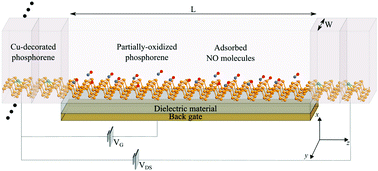Partially-oxidized phosphorene sensor for the detection of sub-nano molar concentrations of nitric oxide: a first-principles study
Abstract
The development of new techniques or instruments for detecting and accurately measuring biomarker concentrations in living organisms is essential for early diagnosis of diseases, and for tracking the effectiveness of treatments. In chronic diseases, such as asthma, precise phenotyping can help predict the response of patients to treatments and reduce the risk of complications. Fractional exhaled nitric oxide (FeNO) is a positive biomarker for eosinophilic asthma in humans, and it can be directly detected in the respiratory tract, at very low and volatile concentrations, which makes real-time measurement a challenge. This work describes the first-principles design and characterization of a molecular- and back-gated electronic field-effect transistor device for the detection and measurement of ultra-low FeNO concentrations (pM–nM) from a person' s exhaled breath, as a cost-efficient alternative to the slower and more expensive techniques based on off-line sputum characterization via mass spectrometry. The proposed device uses a partially oxidized phosphorene semiconducting channel material for FeNO detection, allowing nM L−1 concentration measurements of this analyte in an array configuration with an effective sensing surface area of 8.775 μm2, which results in a predicted limit of detection (LOD) of 19 nM L−1. In spite of the limited stability of phosphorene in oxygen-rich and humid environments, the proposed device would be practical for mobile applications with disposable sensors.



 Please wait while we load your content...
Please wait while we load your content...